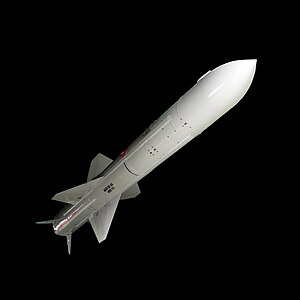Exocet
From Wikipedia, the free encyclopedia
| Exocet | |
|---|---|
 An AM39 aircraft-launched Exocet |
|
| Type | Anti-ship missile |
| Place of origin | France |
| Service history | |
| In service | 1979 |
| Used by | See operators |
| Production history | |
| Designer | 1967-1970: Nord Aviation 1970-1974: Aérospatiale |
| Designed | 1967 |
| Manufacturer | 1979-1999: Aérospatiale 1999-2001: Aérospatiale-Matra 2001-present: MBDA |
| Produced | 1974 |
| Specifications | |
| Weight | 670 kilograms (1,500 lb) |
| Length | 4.7 metres (15 ft 5 in) |
| Diameter | 34.8 centimetres (1 ft 1.7 in) |
|
|
|
| Warhead | 165 kilograms (360 lb) |
|
|
|
| Engine | solid propellant engine
turbojet (MM40 Block 3 version) |
| Wingspan | 1.1 metres (3 ft 7 in) |
| Operational range |
70–180 kilometres (43–110 mi; 38–97 nmi) |
| Flight altitude | Sea-skimming |
| Speed | 315 metres per second (1,030 ft/s) |
| Guidance system |
Inertial and active radar |
| Launch platform |
multi-platform:
|
The Exocet (French for "flying fish") is a French-built anti-ship missile whose various versions can be launched from surface vessels, submarines, helicopters and fixed wing aircraft.
Etymology
The missile's name was given by M. Guillot, then the technical director at Nord Aviation. It is the French word for flying fish from the Latin name exocoetus, a transliteration of the Greek name for flying fish ἐξώκοιτος (exōkoitos), which literally means "lying down outside (ἒξω, κεῖμαι), sleeping outside" because it sometimes stranded itself in boats.
Description
The Exocet is built by MBDA,
a European missile company. Development began in 1967 by Nord as a
ship-launched missile named MM 38. A few years later Aerospatiale and
Nord merged. The basic missile body design was based on the Nord AS30
air to ground tactical missile. The air-launched Exocet was developed in
1974 and entered service with the French Navy five years later.[3]
The relatively compact missile is designed for attacking small- to medium-size warships
(e.g. frigates, corvettes, and destroyers), although multiple hits are
effective against larger vessels, such as aircraft carriers. It is guided inertially in mid-flight and turns on active radar
late in its flight to find and hit its target. As a counter measure
against the air defence around the target, it maintains a very low
altitude during ingress, staying 1–2 m above the sea surface. Due to the
effect of the radar horizon,
this means that the target may not detect an incoming attack until the
missile is only 6000 m from impact. This leaves little time for reaction
and stimulated the design of CIWS.
Its solid propellant
engine gives the Exocet a maximum range of 70 kilometres (43 mi;
38 nmi). The solid-propellant engine was replaced on the Block 3 MM40
ship-launched version of the missile with a solid-propellant booster
and a turbojet sustainer engine which extends the range to 180
kilometres (110 mi; 97 nmi). The submarine-launched version places the
missile inside a launch capsule.
The Exocet has been manufactured in a number of versions, including:
- MM38 (surface-launched)
- AM38 (helicopter-launched - tested only)
- AM39 (air-launched)
- SM39 (submarine-launched)
- MM40 (surface-launched)
The chief competitors to the Exocet are the U.S.-made Harpoon, the Swedish RBS-15 and the Chinese Yingji series.
MM40 Block 3
The newest MM40 version (MM40 block 3) has an improved range of 180
kilometres (110 mi; 97 nmi) through the use of a turbojet engine, and
includes four air intakes to provide continuous airflow to the engine
during high-G maneuvers.
The Block 3 missiles accept GPS guidance system waypoint commands,
which allow them to attack naval targets from different angles and to
strike land targets, giving them a marginal role as a land-attack missile. The Block 3 Exocet is lighter than the previous MM40 Block 2 Exocets.
The 45 Block 3 Exocets were ordered by the French Navy in December
2008. These are not to be new productions but the conversion of older
Block 2 missiles to the Block 3 standard. The first firing of the Block 3
from a warship took place on March 18, 2010, from the French Navy air
defense frigate Chevalier Paul. Besides the French Navy, the Block 3 has been ordered by the navies of Greece, the UAE, Perú, Qatar, Oman and Morocco.

Tidak ada komentar:
Posting Komentar